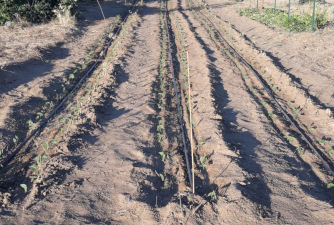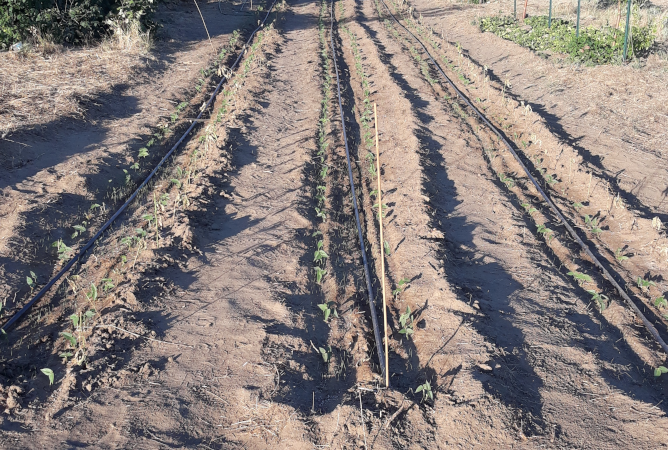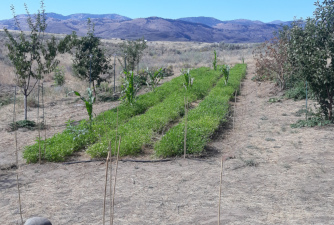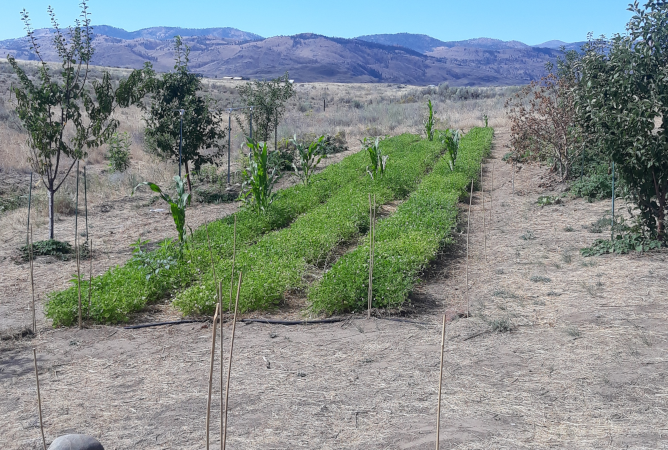Future Dryland Farming Experiments
Our squash test for 2025 seems to be going well and has encouraged us to test the fitness of various other crops to see which are the most productive. Some locations have insufficient moisture to grow corn (even with wide spacing the corn grows 1 - 2 feet high, dries out, and dies), and we should plant either winter wheat or alfalfa in these areas. Winter wheat makes use of winter and early spring moisture and matures before mid summer. In locations where corn has produced without water, we should test other crops to compare yields under similar conditions. Here is a short list of some of the crops we plan to try in 2026.
- Beans - Tepary & Anasazi
- Corn - Various Hopi Corn
- Potatoes - King Harry
- Sorghum - Gaolian Voskovidnyj
- Squash - Various
- Sunchokes - White Fuseau
- Sunflowers - Generic
- Winter Wheat - hard red winter
- Alfalfa
It might be interesting to plant wonderberry since this seems to grow in even the driest areas. We should also test other solanum crops like ground cherries, Physalis peruviana, and tomatillo's. Asparagus sprouts and grows in the corn fields with no water. All of these should be tried in areas where corn does well.
How To Grow Squash Without Irrigation
Squash is one of the 3 sisters (Corn Squash and Beans) used in native planting practices. Our favorites varieties are Kabocha and Buttercup since both of these are not stringy and have a smooth sweet creamy flesh. Summer squash varieties like Zuchini, Yellow Crooken Neck, and Patty Pan (scallop) are also delicious and very productive. These varieties of squash require a considerable amount of water and wilt on hottest days of summer. Hopi Grey Squash is grown in Arizona without irrigation.


Hopi Grey Squash 2025
|


Hopi Grey Squash 2025
|


Hopi Grey Squash 2025
|
In Spring of 2025 an area of Field 2 did not grow well and we replanted the mostly empty area with corn, sorghum, and 4 hills (2 plants each) of Hopi Grey Squash. Hopi Grey Squash seeds were soaked and planted by digging down to moist soil (about 4 - 5 inches) making a 8 inch wide depression and then covering with 1 - 2 inches of moist soil. This created 2 - 3 inch deep depressions which were not watered after planting. These are more like bowls rather than "hills". One hill of squash was lost due to animal damage, but 3 hills with 2 plants each are doing well. To conserve moisture the surrounding soil was filled in around the plants as they got bigger, leveling out the soil.


Hopi Grey Squash/ June 23 2025
|


Hopi Grey Squash / June 23 2025
|


Hopi Grey Squash / June 23 2025
|
The squash are getting bigger. The pictures above were taken the morning after a brief but heavy thunder shower, the leaves are dirty and the soil settled.
Dryland Squash Update Jun 20 2025
The Hopi Grey Squash look fantasic and are growing rapidly. Reports are Hopi Grey Squash can be stringy with large and so we bought some more varieties to test under dryland conditions next year. Stella Blue has been grown under dryland conditions in Northern California with 40+ inches of annual rainfall, so we'll test that. Hidatsa is a native squash from North Dakota that is reported to have a smoother texture than Hopi Grey Squash. Below is a list of some of the squashes we will test in 2026.
- Buttercup Winter Squash
- Delicata Winter Squash
- Hopi Grey Squash
- Hidatsa (North Dakota Native)
- Little Gem Winter Squash
- North Georgia Candy Roaster
- Pueblo Hubbard Squash (Arizona Native)
- Red Kuri Squash
- Stella Blue Squash (a small Hubbard type)
- Tetsukabuto Pumpkin (maxima x moschata hybrid)
- Ute Native Winter Squash (Utah Native)
Dryland Squash Update Jul 02 2025
We noticed that when temperatures got up to 106°F 2 of 3 hills were a little wilted. In 2024 we planted corn at the bottom of 1' trenches and when they got bigger we filled in the trench to serve as mulch and reduce moisture loss. These squash were planted in depressions and the depression was already filled in but it seemed reasonable to continued the process and mulch with more soil. Initially we planned to make shallow trenches and bury the vine portions to mulch with soil and encourage additional roots but the vines were too short and stiff. Instead we took surrounding soil and covered the center of the plants and mounded it up over and around the vines leaving the leaves and growing shoots exposed. We'll continue this process as the plants grow.
Dryland Bean Experiments
In 2020 we grew 3 x 80' rows of tepary beans with drip irrigation and harvested more than 20 lbs of brown tepary beans. We have never tried to grow tepary beans without irrigation. The tepary beans varieties we tried (blue speckled, black, white, and brown) all tasting good but they take a long time to cook. We used a pressure cooker to reduce cooking time but it would be better to find a variety that produces larger beans and cooks faster. The Cascade Gold corn in the picture below didn't produce any ears either due to competition with the beans or being planted too late.


Tepary Beans / 2020
|


Tepary Beans With Cascade Gold Corn / 2020
|
In 2025 our saved beans did not germinate, and we ordered several types of new tepary beans. In June 2025 we planted a 20 hills of Anasazi beans and 20 hills of white tepary beans with irrigation and plant to test these without irrigation in 2026.
Potatoes
Potatoes are mostly water but are considered relatively drought tolerant and we have never tried growing potatoes without irrigation. Potato roots are not deep with few roots 0 - 20 cm, most roots 20 - 60 cm, some roots 60 - 80 cm, and few betweeen 80 - 100 cm. Some potato roots grow more than 3 feet deep. Some varieties of potato have hairy leaves which should reduce water loss (King Harry). After doing some research here is a list of potato varieties we'd like to try.
- Tajfun (medium-early, good root mass, 70-120 days, only 18% decrease with drought)
- Cara (long growth deep roots, late maincrop, high yield, 125-140 days)
- Mikado (early maturing to escape drought, 90-120 days)
- King Harry (hairy leaved potato from bolivia, hairy leaves may reduce water loss)
- Desiree (weak stomatal control and deep roots, 70-90 days)
- Bannock Russet (some expermiments were water was witheld for 13 days)
- Porvenir, Patagonia-INIA, Yaike, and Puyehue-INIA
- GemStar Russet
- Nipigon
- Russet Norkotah (early-maturing)
- Gawin (not available, 17.7% decrease with drought)
- Frig (not available, early maturing to escape drought)
We bought 2.5lbs of King Harry potatoes and planted them mid July 2025 in a location with drip irrigation. It's late to plant potatoes but this variety was a little difficult to find so we are hoping to generate some seed potatoes for a dryland test in 2026.
Sunchokes
We tried sunchokes starting in 2018, and they survive in some places without water but do not produce well. The locations turned out to be relatively dry so we should compare them again by planting together with corn in an area where corn has done reasonably well.
Sunflowers
In 2022 we threw sunflowers in with the corn and the corn in these areas didn't produce ears. Though difficult to harvest sunflowers are drought tolerant and possibly can produce as well as corn without irrgiation. We plant to plant a few around our corn fields in 2026 to help mitigate wind damage.
Winter Wheat
We grew winter wheat in winter 2023 / spring 2024 and it did very well despite not being fertilized in the spring. Winter Wheat grows on moisture accumulated in winter and early spring while it is still too cold for other crops to grow and produce. To grow any volume of wheat you'd need a mini combine for harvesting the grain, but chickens should be able to use the loose heads.
Alfalfa
Alfala is a hardy nitrogen fixing legume and can be use as green manure, mulch, and feed for livestock. We planted some alfalfa by brodcast in 2019 and some of it is doing very well in dry areas but we'd like to plant more. It was too dry to plant alfalfa in the fall of 2024, so we'll try again this fall.
Drought Tolerant Hopi Corn Seeds
Dryland Hopi Corn 2025
Dryland Hopi Corn 2024
Dryland Hopi Corn Experiment
Dryland Sorghum
Winter Wheat 2023